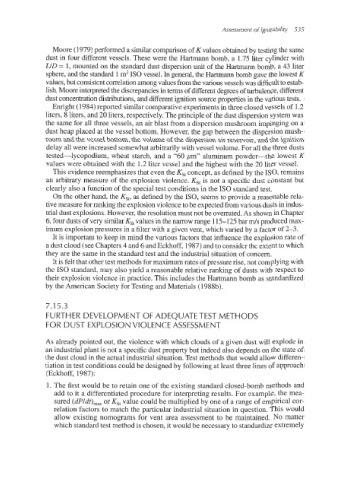Page 568 - Dust Explosions in the Process Industries
P. 568
Assessment of lgnitability 535
Moore (1979) performed a similar comparison of K values obtained by testing the same
dust in four different vessels. These were the Hartmann bomb, a 1.75 liter cylinder with
L/D = 1, mounted on the standard dust dispersion unit of the Hartmann bomb, a 43 liter
sphere, and the standard 1m3IS0 vessel. In general,the Hartmann bomb gave the lowest K
values,but consistentcorrelationamong valuesfrom the variousvesselswas difficultto estab-
lish. Moore interpreted the discrepanciesin terms of differentdegrees of turbulence, different
dust concentration distributions, and different ignition sourceproperties in the various tests.
Entdght (1984)reported similar comparativeexperimentsin three closed vessels of 1.2
liters, 8 liters, and 20 liters, respectively.The principle of the dust dispersion system was
the same for all three vessels, an air blast from a dispersion mushroom impinging on a
dust heap placed at the vessel bottom. However, the gap between the dispersion mush-
room and the vessel bottom, the volume of the dispersion air reservoir, and the ignition
delay all were increased somewhat arbitrarily with vessel volume. For all the three dusts
tested-lycopodium, wheat starch, and a “60 pm” aluminum powder-the lowest K
values were obtained with the 1.2 liter vessel and the highest with the 20 liter vessel.
This evidencereemphasizes that even the K,, concept, as defined by the ISO, remains
an arbitrary measure of the explosion violence. Ks, is not a specific dust constant but
clearly also a function of the special test conditions in the IS0 standard test.
On the other hand, the Kst, as defined by the ISO, seems to provide a reasonable rela-
tive measure for ranking the explosion violence to be expected from various dusts in indus-
trial dust explosions.However, the resolution must not be overrated.As shown in Chapter
6,four dusts of very similarK,, values in the narrow range 115-125 bar ds produced max-
imum explosion pressures in a filter with a given vent, which varied by a factor of 2-3.
It is important to keep in mind the various factors that influence the explosion rate of
a dust cloud (see Chapters4 and 6 and Eckhoff, 1987)and to consider the extent to which
they are the same in the standard test and the industrial situation of concern.
It is felt that other test methods for maximum rates of pressurerise, not complyingwith
the IS0 standard, may also yield a reasonable relative ranking of dusts with respect to
their explosion violence in practice. This includes the Hartmann bomb as standardized
by the American Society for Testing and Materials (1988b).
7.1 5.3
FURTHER DEVELOPMENT OF ADEQUATE TEST METHODS
FOR DUST EXPLOSION VIOLENCE ASSESSMENT
As already pointed out, the violence with which clouds of a given dust will explode in
an industrialplant is not a specific dust property but indeed also depends on the state of
the dust cloud in the actual industrial situation.Test methods that would allow differen-
tiation in test conditions could be designed by following at least three lines of approach
(Eckhoff, 1987):
1. The first would be to retain one of the existing standard closed-bomb methods and
add to it a differentiated procedure for interpreting results. For example, the mea-
sured (dP/dt),, or K,, value could be multiplied by one of a range of empirical cor-
relation factors to match the particular industrial situation in question. This would
allow existing nomograms for vent area assessment to be maintained. No matter
which standard test method is chosen, it would be necessary to standardizeextremely

